1997 CHEVROLET CAVALIER inflation pressure
[x] Cancel search: inflation pressurePage 195 of 388
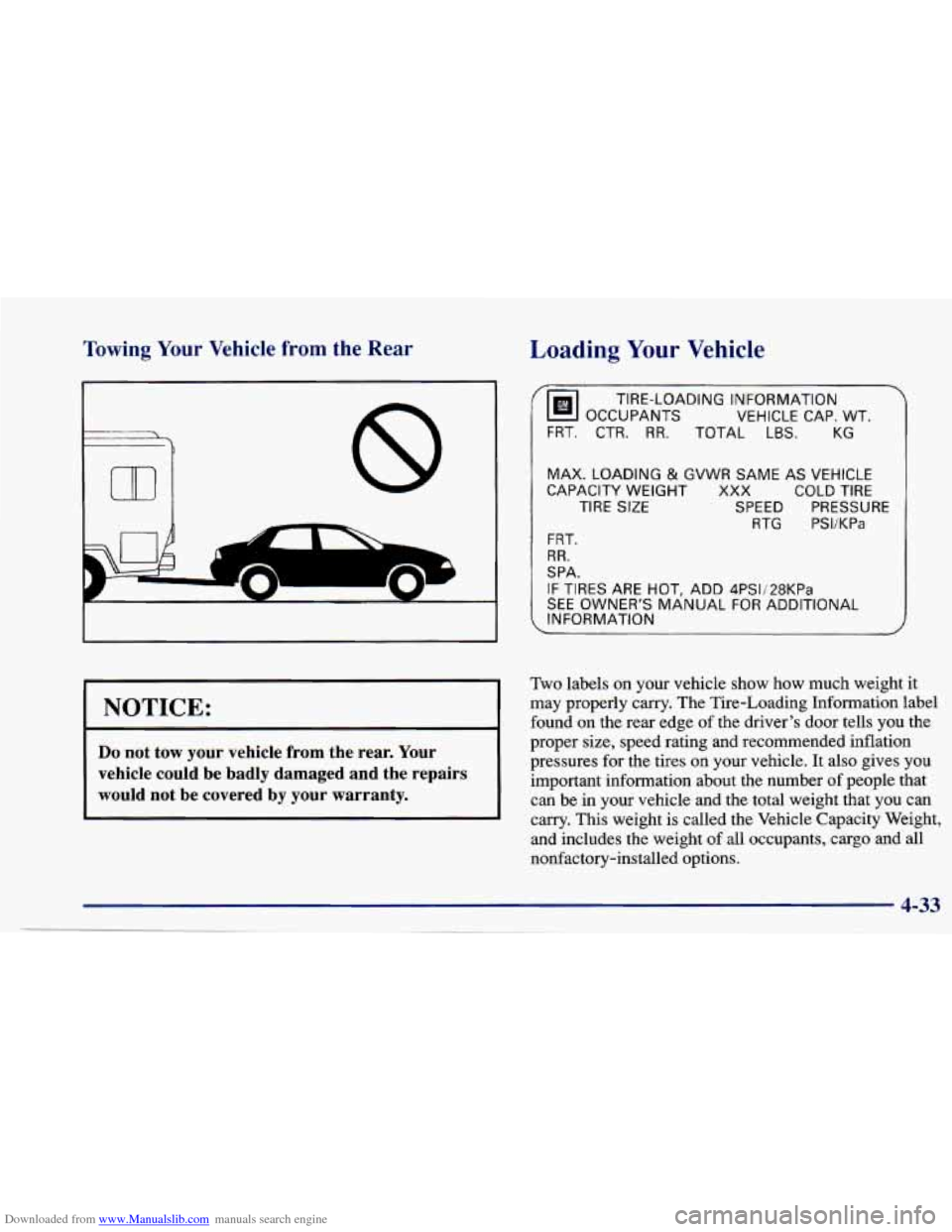
Downloaded from www.Manualslib.com manuals search engine Towing Your Vehicle from the Rear Loading Your Vehicle
I- I
8
‘m OCCUPANTS VEHICLE CAP. WT.
TIRE-LOADING INFORMATION
FRT. CTR.
RR. TOTAL LBS. KG
MAX. LOADING & GVWR SAME AS VEHICLE
CAPACITY WEIGHT XXX
COLD TIRE
TIRE SIZE SPEED PRESSURE
RTG
PSI/KPa
FRT.
RR.
SPA.
IF TIRES ARE HOT, ADD 4PS1/28KPa
SEE OWNER‘S MANUAL FOR ADDITIONAL
INFORMATION
Two labels on your vehicle show how much weight it
found on the rear edge
of the driver’s door tells you the
Do not tow your vehicle from the rear. Your proper size, speed rating and recommended inflation
pressures for the tires on your vehicle. It also gives you
vehicle could be badly damaged and the repairs important information about the number of people that
would not be covered by your warranty. can be in your vehicle and the total weight that you can
carry. This weight is called the Vehicle Capacity Weight,
and includes the weight of all occupants, cargo and all
nonfactory-installed options.
NOTICE: may properly carry. The Tire-Loading Information label
4-33
. ~
Page 240 of 388
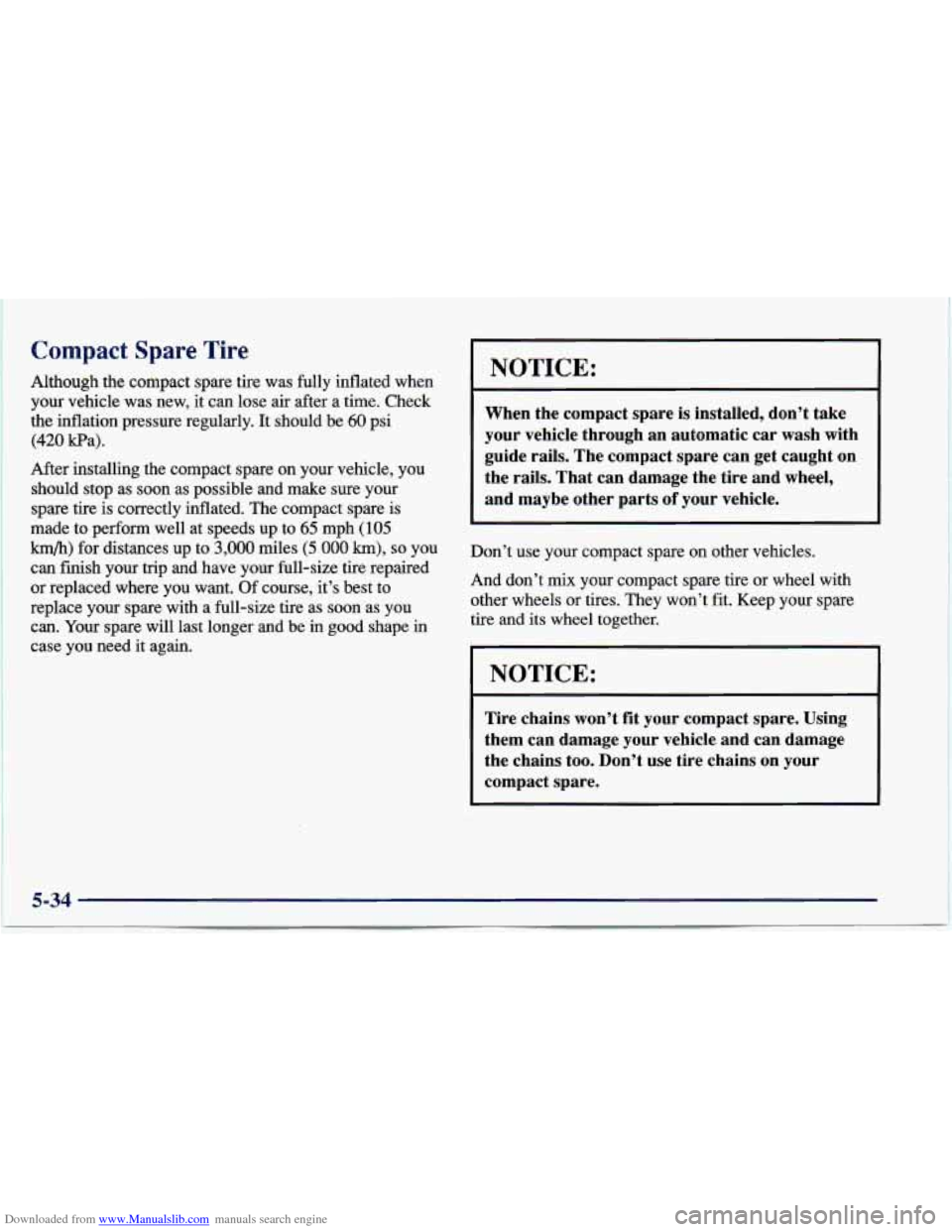
Downloaded from www.Manualslib.com manuals search engine Compact Spare Tire
Although the compact spare tire was fully inflated when
your vehicle was new, it can lose air after
a the. Check
the inflation pressure regularly. It should be
60 psi
(420 Pa).
After installing the compact spare on your vehicle, you
should stop as soon as possible and make sure your spare tire is correctly inflated. The compact spare is
made to perform well at speeds up to
65 mph (105
km/h) for distances up to 3,000 miles (5 000 km), so you
can
finish your trip and have your full-size tire repaired
or replaced where you want. Of course, it’s best to
replace your spare with a full-size tire as soon as
you
can. Your spare will last longer and be in good shape in
case you need it again.
NOTICE:
When the compact spare is installed, don’t take
your vehicle through an automatic car wash with
guide rails. The compact spare can get caught on
the rails. That can damage the tire and wheel,
and maybe other parts
of your vehicle.
Don’t use your compact spare on other vehicles.
And don’t mix your compact spare tire or wheel with
other wheels or tires. They won’t fit. Keep your spare
tire and its wheel together.
NOTICE:
Tire chains won’t fit your compact spare. Using
them can damage your vehicle and can damage
the chains too. Don’t use tire chains on your
compact spare.
5-34
Page 283 of 388
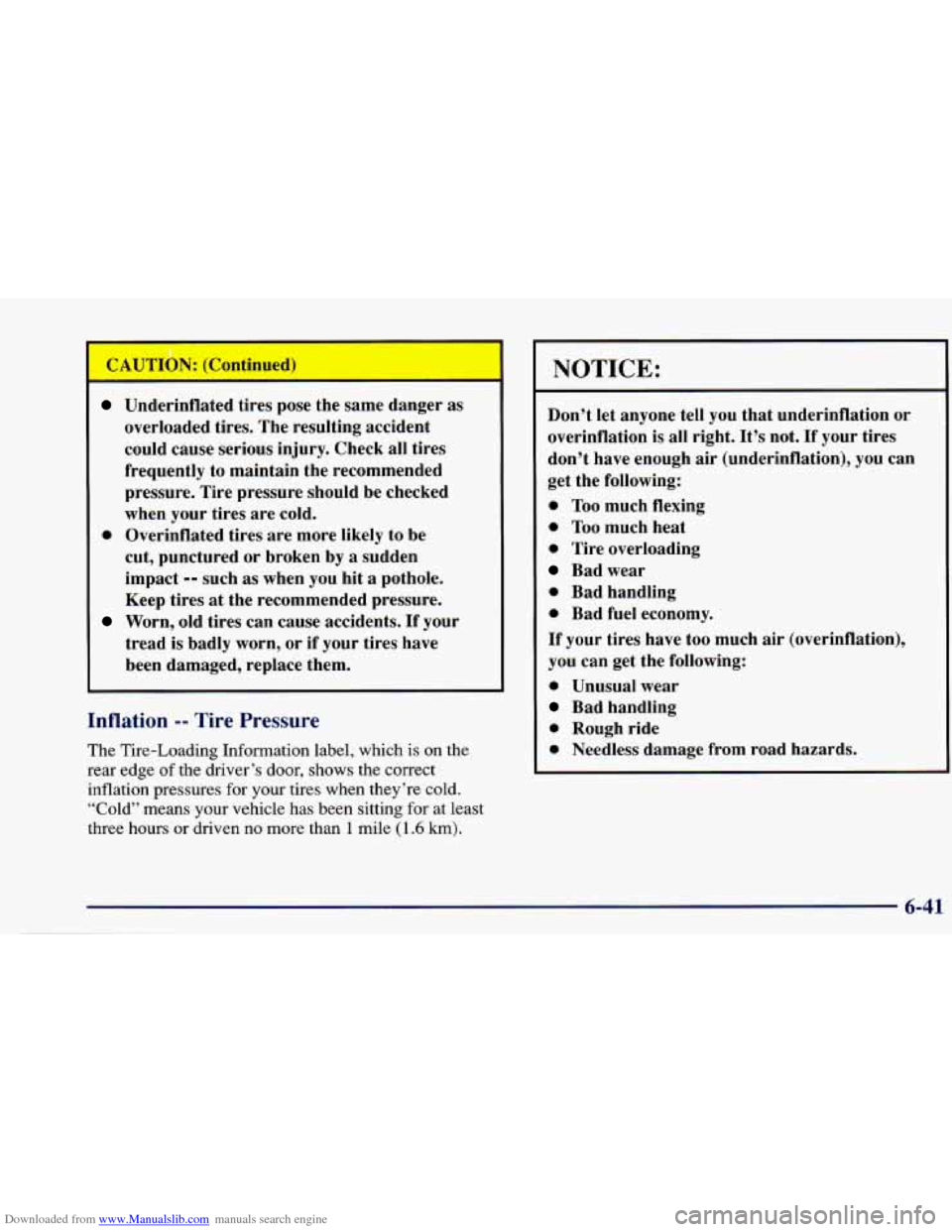
Downloaded from www.Manualslib.com manuals search engine Underinflated tires pose the same danger as
overloaded tires. The resulting accident
could cause serious injury. Check
all tires
frequently to maintain the recommended
pressure. Tire pressure should be checked
when your tires are cold.
cut, punctured or broken by
a sudden
impact
-- such as when you hit a pothole.
Keep tires at the recommended pressure.
Worn, old tires can cause accidents. If your
tread is
badly worn, or if your tires have
been damaged, replace them.
0 Overinflated tires are more likely to be
Inflation -- Tire Pressure
The Tire-Loading Information label, which is on the
rear edge of the driver’s door, shows the correct
inflation pressures
for your tires when they’re cold.
“Cold” means your vehicle has been sitting for at least
three hours or driven
no more than 1 mile (1.6 km).
NOTICE:
Don’t let anyone tell you that underinflation or
overinflation is
all right. It’s not. If your tires
don’t have enough air (underinflation), you can
get the following:
0 Too much flexing
0 Too much heat
0 Tire overloading
Bad wear
0 Bad handling
0 Bad fuel economy.
If your tires have too much
you can get the following:
0 Unusual wear
Bad handling
0 Rough ride air
(overinfl
0 Needless damage from road hazards. ati
6-41
Page 284 of 388
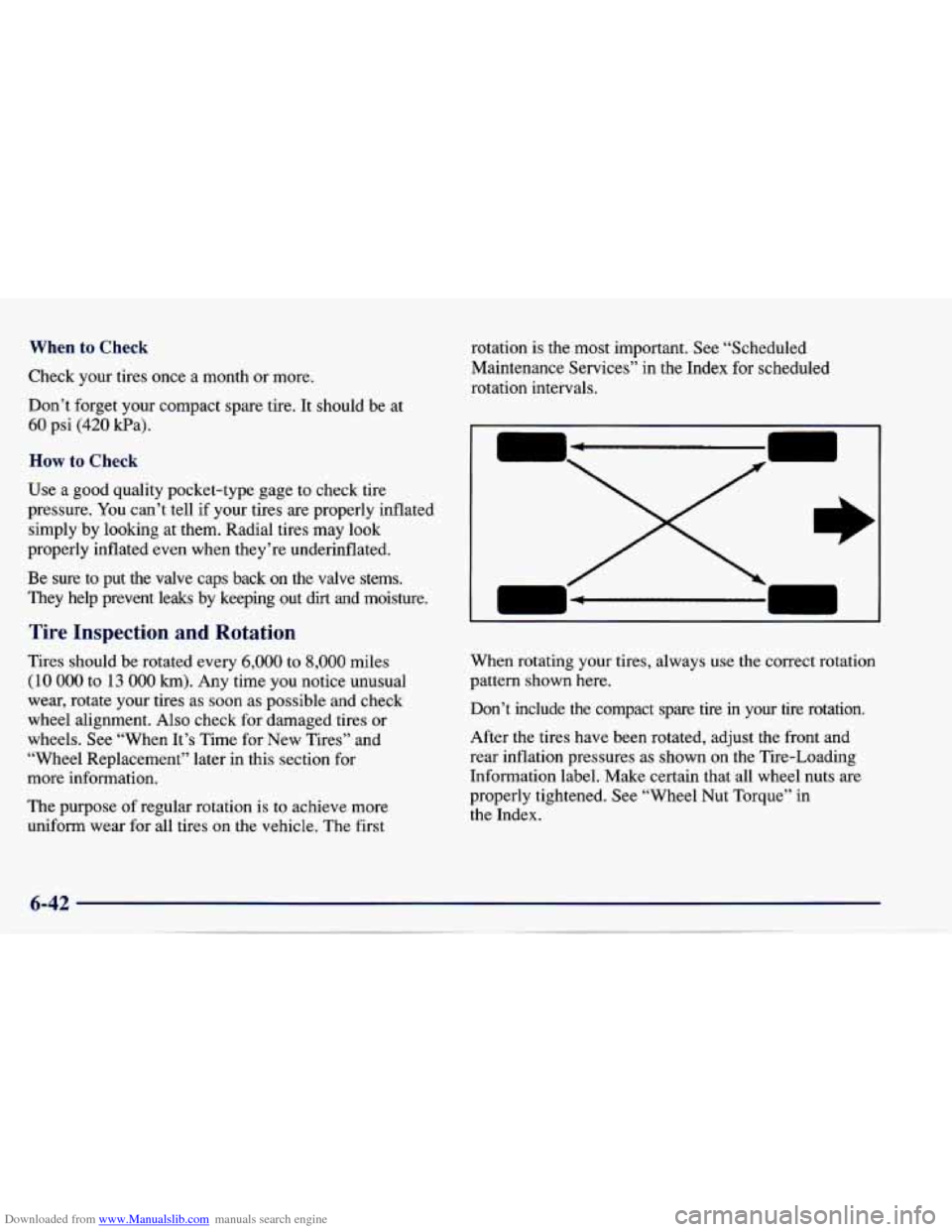
Downloaded from www.Manualslib.com manuals search engine When to Check
Check your tires once a month or more.
Don’t forget your compact spare tire. It should be at
60 psi (420 Pa).
How to Check
Use a good quality pocket-type gage to check tire
pressure.
You can’t tell if your tires are properly inflated
simply by looking at them. Radial tires may look
properly inflated even when they’re underinflated.
Be sure to put the valve caps back on the valve stems.
They help prevent leaks by keeping out dirt
and moisture.
Tire Inspection and Rotation
Tires should be rotated every 6,000 to 8,000 miles
(10
000 to 13 000 km). Any time you notice unusual
wear, rotate your tires as soon as possible and check
wheel alignment. Also check for damaged tires or
wheels. See “When It’s Time for New Tires” and
“Wheel Replacement” later in this section for
more information.
The purpose of regular rotation is to achieve more
uniform wear for all tires on the vehicle. The first rotation is the most important.
See “Scheduled
Maintenance Services’’ in the Index for scheduled
rotation intervals.
n
*
I1
When rotating your tires, always use the correct rotation
pattern shown here.
Don’t include the compact spare tire in your tire rotation. \
After the tires have been rotated, adjust the front and
rear inflation pressures
as shown on the Tire-Loading
Information label. Make certain that all wheel nuts are
properly tightened. See “Wheel
Nut Torque” in
the Index.
Page 349 of 388

Downloaded from www.Manualslib.com manuals search engine Part B: Owner Checks and Services
Listed below are owner checks and services which
should be performed at the intervals specified to help
ensure the safety, dependability and emission control
performance of your vehicle.
Be sure any necessary repairs are completed at once.
Whenever any fluids or lubricants are added to your
vehicle, make sure they are the proper ones, as shown
in Part D.
At :ach Fuel Fill
It is important for you or a service station attendant to
per3cor-m these underhood checks at each
fuel fill.
Engine Oil Level Check
Check the engine oil level and add the proper oil if
necessary. See “Engine Oil”
in the Index for
further details.
Engine Coolant Level Check
Check the engine coolant level and add coolant mixture
if nec
.I :ssary. See “Engine Coolant” in the Index for
further details.
Windshield Washer Fluid Level Check
Check the windshield washer fluid level in the
windshield washer tank and add the proper fluid if
necessary. See “Windshield Washer Fluid”
in the Index
for further details.
At Least Once a Month
Tire Inflation Check
Make sure tires are inflated to the correct pressures. See
“Tires” in the Index for further details.
Cassette Deck Service
Clean cassette deck. Cleaning should be done every
50 hours of tape play. See “Audio Systems” in the Index
for further details.
Page 384 of 388
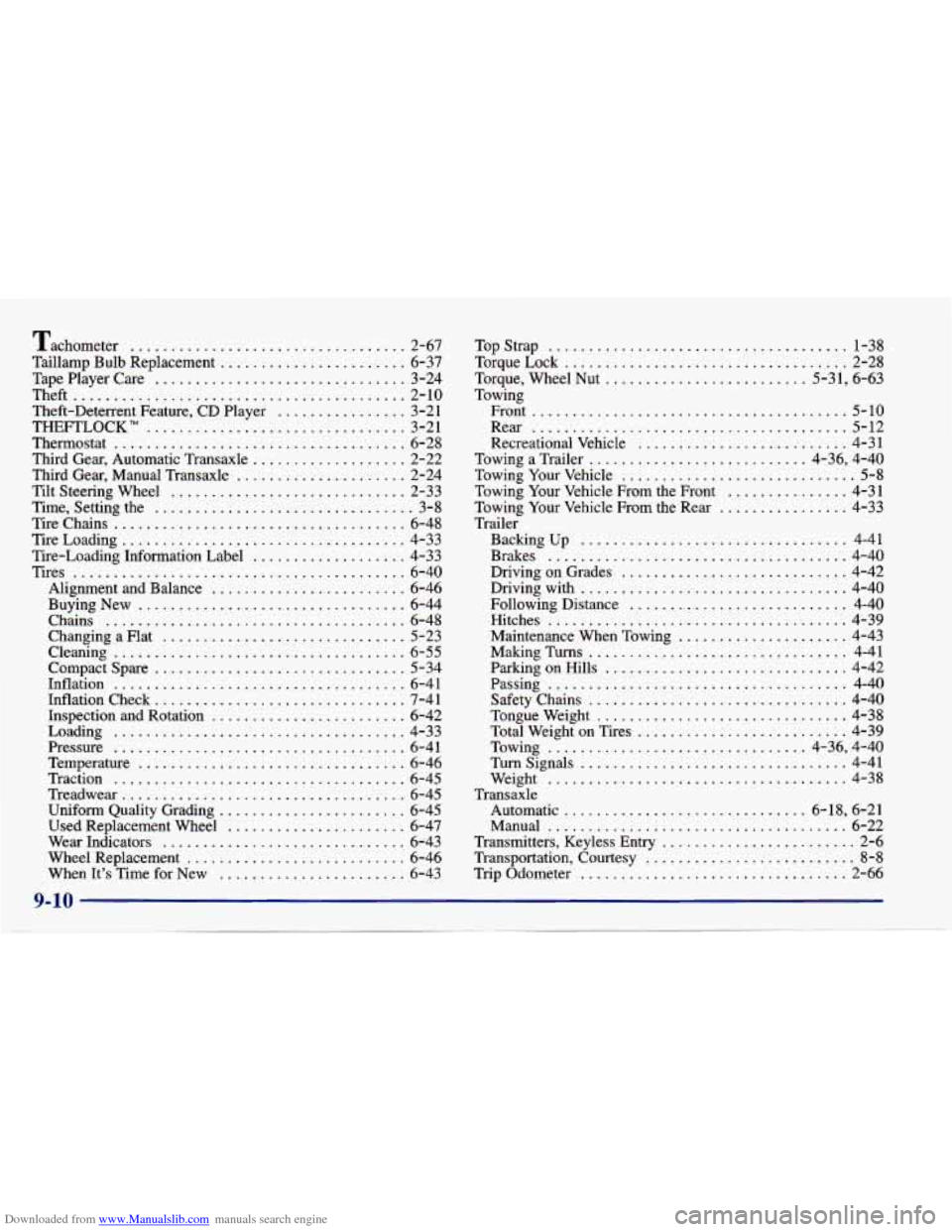
Downloaded from www.Manualslib.com manuals search engine Tachometer .................................. 2-67
Taillamp Bulb Replacement
....................... 6-37
TapePlayerCare
............................... 3-24
Theft
......................................... 2-10
Theft-Deterrent Feature. CD Player ................ 3-21
THEFTLOCK
.................................. 3-21
Thermostat
.................................... 6-28
Third Gear. Automatic Transaxle
................... 2-22
Third Gear. Manual Transaxle
..................... 2-24
Tilt Steering Wheel
............................. 2-33
Time. Setting the
................................ 3-8
Tirechains
.................................... 6-48
TireLoading
................................... 4-33
Tire-Loading Information Label
................... 4-33
Tires
......................................... 6-40
Alignment and Balance
........................ 6-46
Buying New
................................. 6-44
Chains
..................................... 6-48
ChangingaFlat
.............................. 5-23
Cleaning
.................................... 6-55
Compact Spare
............................... 5-34
Inflation
.................................... 6-41
Inflation Check
............................... 7-41
Inspection and Rotation
........................ 6-42
Loading
.................................... 4-33
Pressure
.................................... 6-41
Temperature
................................. 6-46
Traction
.................................... 6-45
Treadwear
................................... 6-45
Uniform Quality Grading
....................... 6-45
Used Replacement Wheel
...................... 6-47
Wear Indicators
.............................. 6-43
Wheel Replacement
........................... 6-46
When It’s Time for New
....................... 6-43
B-10 - -
TopStrap ..................................... 1-38
TorqueLock
................................... 2-28
Torque. Wheel
Nut ......................... 5.31. 6.63
Towing Front
....................................... 5-10
Rear
....................................... 5-12
Recreational Vehicle
.......................... 4-31
Towing a Trailer
........................... 4.36. 4.40
Towing Your Vehicle
............................. 5-8
Towing Your Vehicle From the Front
............... 4-31
Towing Your Vehicle From the Rear
................ 4-33
Trailer
Backing
Up ................................. 4-41
Brakes
..................................... 4-40
Driving on Grades
............................ 4-42
Driving with
................................. 4-40
Following Distance
........................... 4-40
Hitches
..................................... 4-39
Maintenance When Towing
..................... 4-43
Making Turns
................................ 4-41
Passing
..................................... 4-40
Tongueweight
............................... 4-38
Total Weight on Tires
.......................... 4-39
Turnsignals
................................. 4-41
ParkingonHills
.............................. 4-42
Safety Chains
................................ 4-40
Towing
................................ 4.36. 4.40
Weight
..................................... 4-38
Transaxle
Automatic
.............................. 6.18. 6.21
Manual
..................................... 6-22
Transmitters. Keyless Entry ........................ 2-6
Transportation. Courtesy
.......................... 8-8
Trip Odometer ................................. 2-66